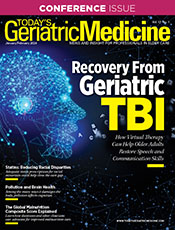
January/February 2024
The Last Word: Opioid Andropause in Older Adult Men: A Quiet Calamity How Palliative Care Can Help With the advent of modern medicine, patients live longer yet may complain of suffering more. Over their lifetimes, older adults can amass myriad painful ailments, but gerontologists can treat pain and improve their quality of life with the use of opioids. These medications, however, may have significant consequences, particularly in geriatric patients. Since the beginning of this century, opioid use has soared, and the age-related death rate from that use has increased severalfold during the past two decades. A major shortcoming is that there’s a paucity of clinical trials and data about the use of opioids in gerontology. Opioid toxicities such as nausea, constipation, or somnolence are nonspecific. They may appear so subtly as to be mistakenly ascribed to “old age.” Yet older adults have the same propensity toward toxicities as do younger patients, such as decreased cognition and sedation, which can lead to falls. Patients may appear sullen and be misdiagnosed as depressed. Constipation, respiratory depression, and dysrhythmias (eg, QT syndrome) may occur as well. Opioid-induced hypogonadism, or andropause, is another significant consequence. It’s quietly intrusive, replacing misery for pain cessation. Opioids lead to an aging effect on older men as they disrupt gonadotropins. Normally, the hypothalamus produces gonadotropin-releasing hormone (GnRH), which, in turn, signals the pituitary release of follicle-stimulating hormone (FSH) and luteinizing hormone (LH). The former maintains spermatogenesis, while the latter controls testosterone synthesis by the Leydig cells in the testes. As men age, they tend to project a mixed picture of hypogonadism—a primary and secondary form, which manifests both a low GnRH and a decreased LH concentration. Total serum testosterone starts to decline after age 40 and can be reduced by as much as one-half for men in their mid-70s. Opioids decrease GnRH, leading to an earlier decrease in LH and FSH. It’s also believed that opioids can augment prolactin production, which can further inhibit GnRH. Studies have shown that almost 90% of older men who use opioids show a decreased free testosterone along with the LH and FSH due to the medication. Besides sexual side effects, this can cause a loss of muscle mass and muscle strength, depression, anxiety, decreased energy, flushing, sweating, and osteoporosis (leaving them prone to fractures). These toxicities occur with variable severity and onset. They may appear subtly, quietly, even mimicking normal aging to their caretakers. The signs of opioid andropause may be dismissed as dementia by the family. Only suspicion by the health care provider may reveal that something is amiss in the patient. The signs and symptoms of opioid-induced hypogonadism are common amongst other ailments too. This can obscure the diagnosis as the provider will focus on more common diseases. While opioid-induced hypogonadism is likely never the first on the diagnostic list, it should never be absent from the list. A suspicion should always be present. In 2015, the FDA expressed reservations over testosterone administration to older adults due to studies that suggested an increased risk of heart attack and stroke. Clearly, testosterone repletion is a source of potential problems for the patient and trepidation for their gerontologists. If the older male suffers from opioid-induced hypogonadism, the opioid may need a significant dose attenuation, drug rotation, or complete abandonment. Discerning the side effects of medication is just as important as treating the pain. And this decision point may be where the experience of a palliative care consultant—a recent and potentially useful adjunct to gerontological practice—can best serve the gerontologist. As a young medical specialty, palliative care is relatively underused, but it has much to offer. Like their contemporaries in hospice, palliative care consultants focus on the alleviation of painful and obtrusive signs and symptoms of disease. The palliative care consultant can initiate pain therapy for older adults, vary dosages if they appear toxic, or completely “rotate” the medication—the opioid—to another form(at) if necessary. Along with the service, the consultants can educate the family on the older adult’s medicines. They can make certain that naloxone (for overdose) or methylnaltrexone (for opioid constipation) are available. They can arrange for steroid injections (for joints), neuroablation, or palliative radiation (in the instance of painful superficial tumors). The service can monitor the patient at home, measuring the efficacy of the pain regimen, preventing polypharmacy, and monitoring for drug diversion. This specialty has proven itself to be exemplary in dealing with chronic problems of debilitating disease. A palliative care consultant can mitigate the issue of opioid-induced andropause, and the onus of pain management doesn’t have to belong solely to the gerontologist. The need for pain control for older male patients can now be met without the toxicity they can ill afford. — Robert Killeen, MD, is a semiretired physician in Tampa, Florida. He practices hematology, oncology, and internal medicine, and for many years served the local hospice. He now writes about medical topics and historical nonfiction. |
